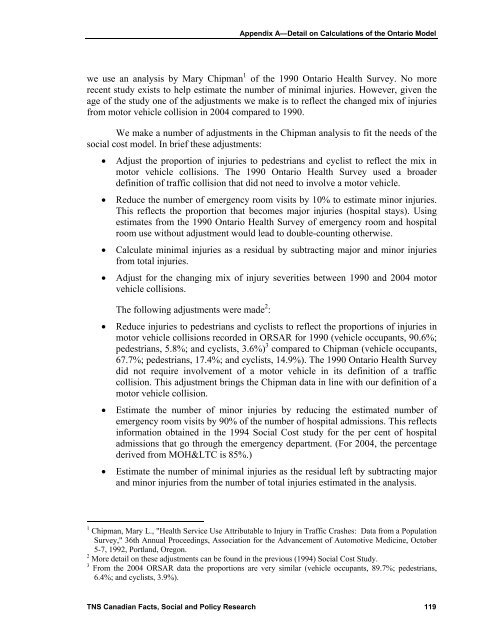Keith Vodden Dr. Douglas Smith - Transports Canada
Keith Vodden Dr. Douglas Smith - Transports Canada
Keith Vodden Dr. Douglas Smith - Transports Canada
You also want an ePaper? Increase the reach of your titles
YUMPU automatically turns print PDFs into web optimized ePapers that Google loves.
Appendix A—Detail on Calculations of the Ontario Model<br />
we use an analysis by Mary Chipman 1 of the 1990 Ontario Health Survey. No more<br />
recent study exists to help estimate the number of minimal injuries. However, given the<br />
age of the study one of the adjustments we make is to reflect the changed mix of injuries<br />
from motor vehicle collision in 2004 compared to 1990.<br />
We make a number of adjustments in the Chipman analysis to fit the needs of the<br />
social cost model. In brief these adjustments:<br />
• Adjust the proportion of injuries to pedestrians and cyclist to reflect the mix in<br />
motor vehicle collisions. The 1990 Ontario Health Survey used a broader<br />
definition of traffic collision that did not need to involve a motor vehicle.<br />
• Reduce the number of emergency room visits by 10% to estimate minor injuries.<br />
This reflects the proportion that becomes major injuries (hospital stays). Using<br />
estimates from the 1990 Ontario Health Survey of emergency room and hospital<br />
room use without adjustment would lead to double-counting otherwise.<br />
• Calculate minimal injuries as a residual by subtracting major and minor injuries<br />
from total injuries.<br />
• Adjust for the changing mix of injury severities between 1990 and 2004 motor<br />
vehicle collisions.<br />
The following adjustments were made 2 :<br />
• Reduce injuries to pedestrians and cyclists to reflect the proportions of injuries in<br />
motor vehicle collisions recorded in ORSAR for 1990 (vehicle occupants, 90.6%;<br />
pedestrians, 5.8%; and cyclists, 3.6%) 3 compared to Chipman (vehicle occupants,<br />
67.7%; pedestrians, 17.4%; and cyclists, 14.9%). The 1990 Ontario Health Survey<br />
did not require involvement of a motor vehicle in its definition of a traffic<br />
collision. This adjustment brings the Chipman data in line with our definition of a<br />
motor vehicle collision.<br />
• Estimate the number of minor injuries by reducing the estimated number of<br />
emergency room visits by 90% of the number of hospital admissions. This reflects<br />
information obtained in the 1994 Social Cost study for the per cent of hospital<br />
admissions that go through the emergency department. (For 2004, the percentage<br />
derived from MOH<C is 85%.)<br />
• Estimate the number of minimal injuries as the residual left by subtracting major<br />
and minor injuries from the number of total injuries estimated in the analysis.<br />
1 Chipman, Mary L., "Health Service Use Attributable to Injury in Traffic Crashes: Data from a Population<br />
Survey," 36th Annual Proceedings, Association for the Advancement of Automotive Medicine, October<br />
5-7, 1992, Portland, Oregon.<br />
2 More detail on these adjustments can be found in the previous (1994) Social Cost Study.<br />
3 From the 2004 ORSAR data the proportions are very similar (vehicle occupants, 89.7%; pedestrians,<br />
6.4%; and cyclists, 3.9%).<br />
TNS Canadian Facts, Social and Policy Research 119
















